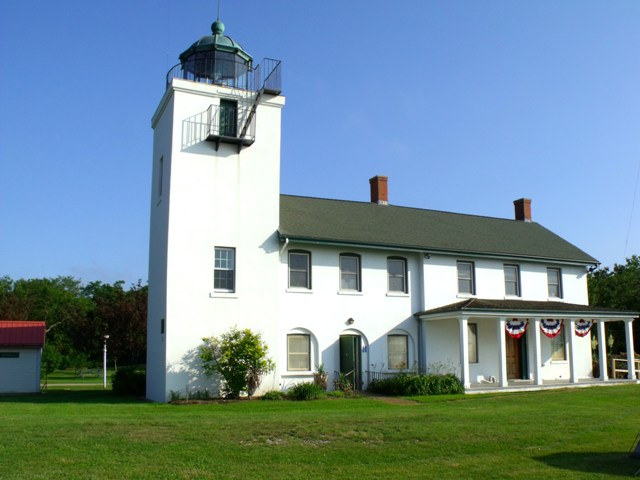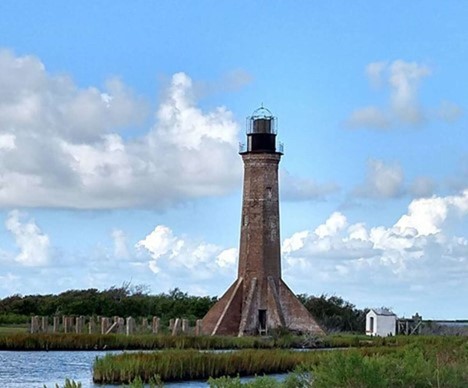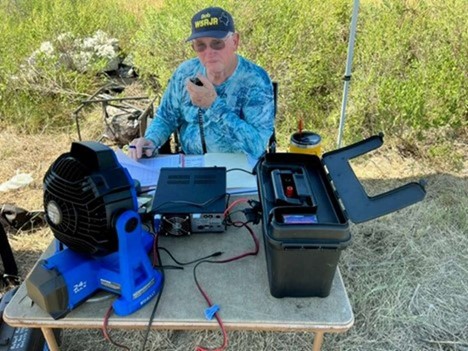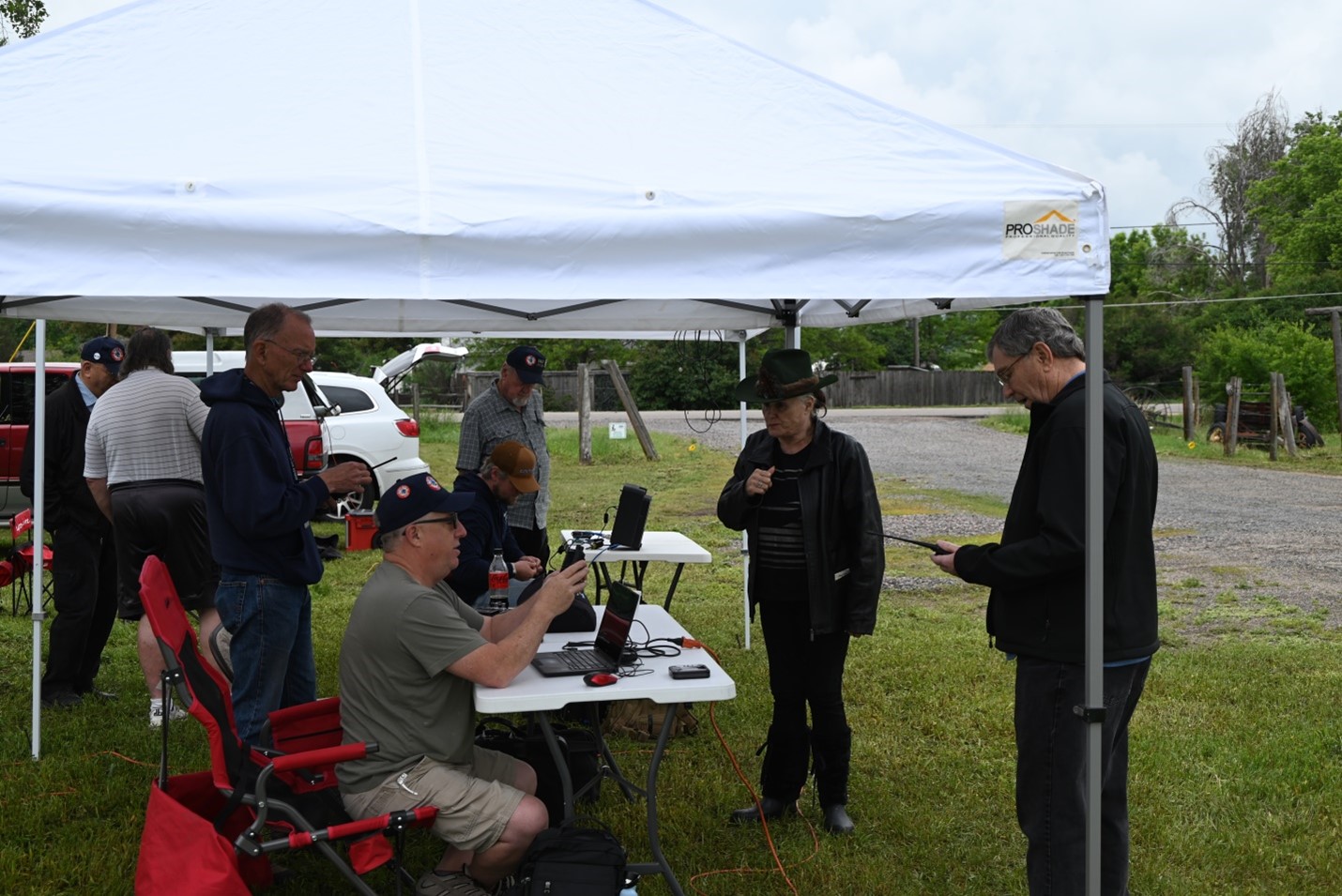 September 19, 2023 Editor: Michael Walters, W8ZY | |||||
New York Club Operates Ham Radio in Honor of National Lighthouse Day August 7 was National Lighthouse Day, and the Peconic Amateur Radio Club (PARC) participated by operating at Horton Point Light (US0023) in Southold, New York.
Our operations were a great success, regardless of the rain early on in the day. Our team set up two HF transceivers, one on commercial power and the other on battery power. Both transceivers were successful in advertising Horton Point Light's existence. Eleven contacts were logged within the continental US. Our club has received requests for our commemorative Horton Point Lighthouse National Lighthouse Day QSL card. Three club members (Don, N2QHV; Gene, KC2ZQL, and Dick, N2YIB) operated the stations and were observed by other members (Charles, K2GLP; Doug, KD2TJW, and Amal, N2ZUY) who provided encouragement and advice. PARC also participated in the annual International Lighthouse Lightship Weekend in August. Members activated the Plum Island Lighthouse (US0226), Orient Point Lighthouse (US0273), Long Beach Bar "Bug" Lighthouse (US0163), and Horton Point Lighthouse (US0023). A Historic Texas Lighthouse Was Activated for International Lighthouse Lightship Weekend Restorations are underway to rehabilitate a historic lighthouse back to its former glory, and four local radio amateurs set out on a mission in late August to broadcast the efforts with the world. The Sabine Pass Lighthouse sits on the Louisiana side of the Sabine River, where the river empties into the Gulf of Mexico. Sabine Pass was one of the more than 20 lighthouses the federal government built along the Texas coast in 1852 to help maritime crews navigate their way in and around the Gulf of Mexico. Damage during the Civil War, followed by natural disasters, sea erosion, and a shifting coastline destroyed the lighthouses, but five still stand today. The Cameron Preservation Alliance is in charge of renovating the Sabine Pass Lighthouse and has been working to raise money for the costly repairs since 2017. During International Lighthouse Lightship Weekend, amateur radio operators from around the world promote the preservation of lighthouses and lightships in nearly 95 countries. This year, four men from surrounding Gulf Coast communities traveled to the Sabine Pass Lighthouse to broadcast from the area.
Bob Rose, W5RJR, said the group, which also consisted of Glen Rose, KI5TXY, Steve Gomez, KE5O, and Verne King, K5QDA, set up three stations under the special call sign that was obtained for the event, W5P, successfully contacted several other radio nets, and even reached stations in Europe, Mexico, and the Caribbean. "There was no contest pressure; no push to make as many contacts as could be accomplished, and no requirements to keep up with points, scores, or reporting," Rose said. "There was no rush to terminate contacts to move on to the next one." During their broadcast and conversations, the group discussed the history of the Sabine Pass Lighthouse, the Cameron Preservation Alliance's work to restore the 87-foot-tall structure, and the alliance's mission to search for the original lens used in the lamp.
Over the course of the 2-day event, the operators made 19 lighthouse contacts, two lightship contacts, nine Parks on the Air contacts, and one contact with the USS Little Rock CL-92 ship in the Buffalo and Erie County Naval & Military Park in New York. Contacts were made with 26 US states, Puerto Rico, and seven foreign countries, including Canada, Mexico, the British Virgin Islands, Italy, France, and Germany. By Sana Ameer, Beaumont Enterprise A Fresh Take On In-Person Meetings Like many radio clubs across the country, most of the Denver Radio Club's (DRC) activities were curtailed by the pandemic and local restrictions at our meeting location. The club quickly transitioned from in-person to web-based meetings, allowing presenters from around the country to be utilized without requiring any travel. Club members appreciated having more diverse guest speakers covering a greater breadth of topics. Members didn't need to travel to meetings, which gave them more time for evening activities. Unfortunately, our meeting location still maintains meeting restrictions, so the club has continued with the remote-meeting forum. Once the pandemic restrictions relaxed, DRC surveyed its members, seeking input on having the general meetings return to being in person or remain being remote. Overwhelmingly, the club elected to continue the web-based meetings, but this left a void in those seeking the camaraderie from meeting in person. Club officers elected to conduct four extra club gatherings, located mostly in our usual Field Day spot. These events, branded DRC Saturdays, are open to members and non-members alike.
The first event, held on April 29, was billed as Member Show and Tell. Attendees brought what they built and got it on the air. There was a demonstration of FT8/digital, with time to get on the air using that mode. In addition, Florida was having their QSO party, and the club allowed attendees to operate the club station with more anticipated activity. On June 3, DRC hosted an Elmer Picnic in the Park. Hotdogs, hamburgers, and questions and answers were being served. Handheld transceiver programming was offered to those unsure of how to create code plugs and get their new radios on the air. A radio technician with an Aeroflex service monitor tested radios for compliance with radio specifications. Many radios were checked, but unfortunately the weather turned, and the hotdogs and burgers had to wait for better weather. One issue that kept coming up was that amateurs wanted more opportunities to operate within their license classes. DRC elected to do a Parks on the Air activation on July 15 at a nearby wildlife management area that doesn't require park admission fees. Several radios, bands, and modes were operational for those attending. Once again, hotdogs and refreshments were an added incentive. Propagation didn't cooperate fully, but a good time was had by all, and the event was highly successful. Finally, our last DRC Saturday of the year was September 16. This event included a Winlink demonstration and clinic. Its purpose was to assist those having difficulties in setting up their radio for this email network and provided an opportunity to use it. A GOTA station was available for those wanting the chance to try HF. Overall, the DRC Saturday events have been an immense success. Making face-to-face contact has been positive for club morale. Going forward, the club plans to continue these events. For more information, visit us at W0TX.org. Upcoming Club Development Series Installment The next installment of the ARRL Club Development Series is scheduled for September 21 at 7:00 PM Eastern. This online seminar will be recorded and become a part of the ARRL Learning Center. If you wish to watch it live, the registration link is below. The presentation will be by Assistant Director of the ARRL New England Division Anita Kemmerer, AB1QB, and the subject will be the Club Commission Program. https://us06web.zoom.us/webinar/register/WN_3Q6svUixRRuzycTDNIOieg New Club-Level Awards There are two big events for new hams. The first is when they pass their exam and get their new license. The second one, which may be scarier for many, is making their first contact. It may be on a handheld transceiver talking to the local repeater or by way of a GOTA station on HF. The first contact is special. There is a new certificate available to commemorate that momentous event. On the ARRL website, at www.arrl.org/awards, you'll find a list of available awards, with one being the First Contact Award. This certificate is a fillable PDF that can be printed or saved. Make a new ham's first contact special and give them some new wallpaper to start their collection. Another award has also been reworked, and that is the Mentor Award. If a friendly ham helped you get started, taught a class, or introduced you to a digital mode, thank them with the Mentor Award. It is also a fillable PDF and can be found on the same page. These are more awards that clubs and individuals can use to help promote ham radio. Think about how your club can use them! Submitting Info for this Newsletter ARRL Club News is for radio clubs to show how they are working in the community and the hobby to advance amateur radio. If your club completes a project, supports an event, does an EmComm activation, or activates a park, we want to hear about it. You can submit your newsletter article to us at clubs@arrl.org. We like to get them as text or Word files instead of PDFs. If you have pictures, please submit them with caption information, as well as the name and call sign of the photographer. We want to highlight the good work being done by the clubs and show others in the community. Think of this as a chance to show off your club and your programs. How to Plan and Apply for an ARRL Hamfest or Convention If your amateur radio club is planning to host a convention, hamfest, tailgate, or swapfest, please consider applying for it to be an ARRL-sanctioned event. To learn what it means to be an ARRL-sanctioned event, and to get some ideas on how to prepare for and conduct a hamfest or convention, visit www.arrl.org/arrl-sanctioned-events. To have your event sanctioned, complete the online application at www.arrl.org/hamfest-convention-application. The ARRL Hamfests and Conventions Calendar can be found online at www.arrl.org/hamfests. In addition, the Convention and Hamfest Calendar that runs in QST each month also presents information about upcoming events. Important Links ARRL Home: www.arrl.org Find an ARRL Affiliated Club: www.arrl.org/clubs Find your ARRL Section: www.arrl.org/sections Find a license class in your area: www.arrl.org/class Find a license exam in your area: www.arrl.org/exam Find a hamfest or convention: www.arrl.org/hamfests Email ARRL Clubs: clubs@arrl.org | |||||









